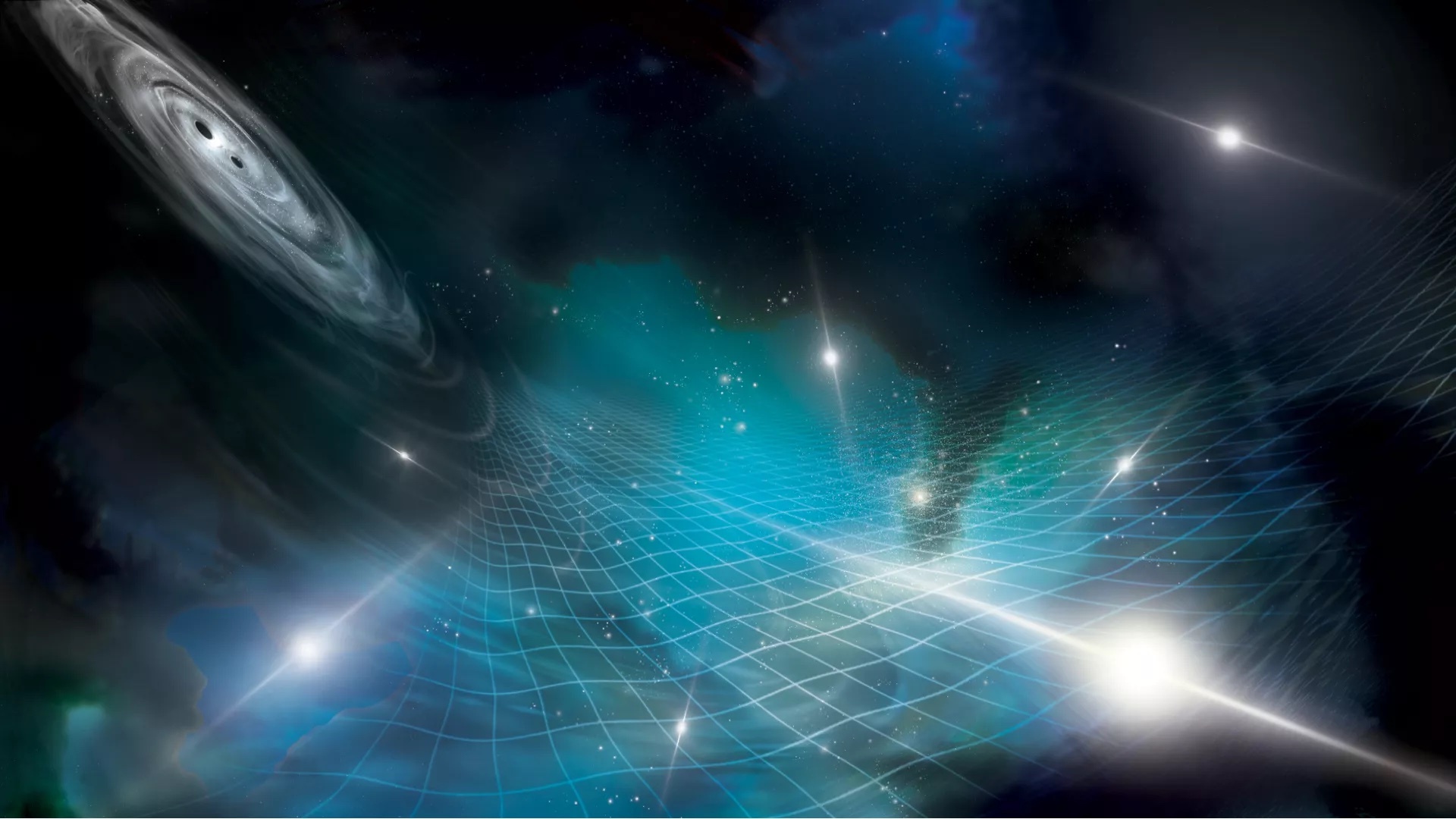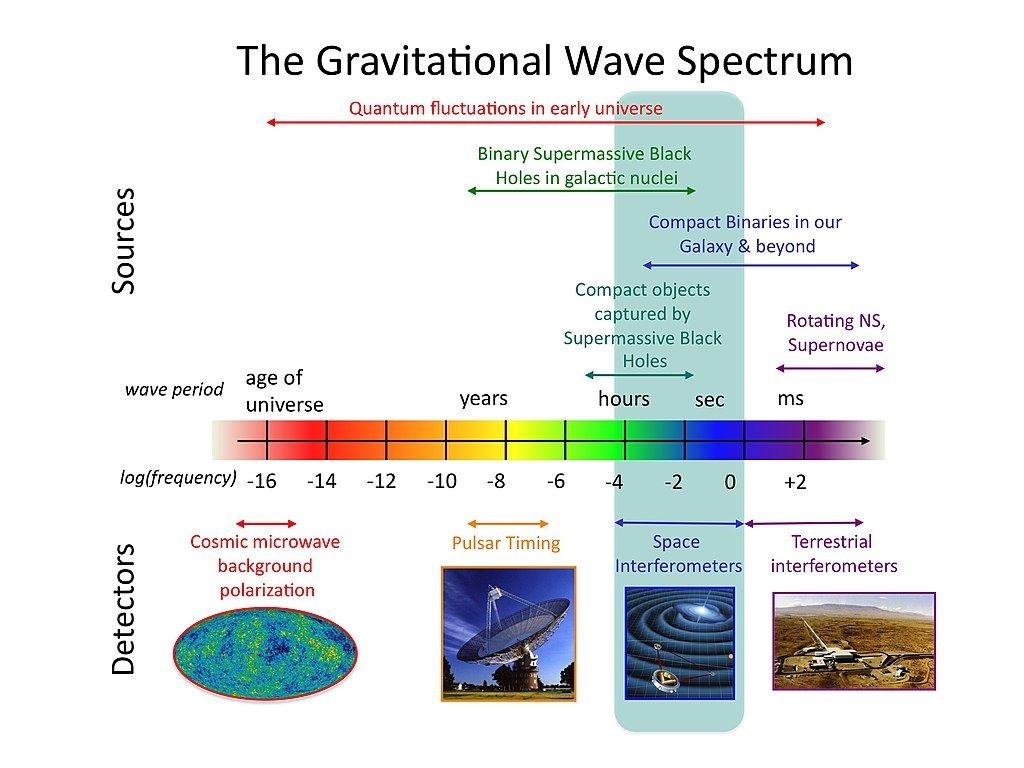13.08.2023
Scientists' recent detection of low-frequency gravitational waves may shed light on what's causing a constant rumble of ripples in the very fabric of space and time.

An illustration of gravaitional waves ringing through spacetime and the supermassive black hole binaries that may have launched them. (Image credit: Aurore Simonnet for the NANOGrav Collaboration)
Earlier this year, after 15 years of searching, scientists finally heard the background hum of low-frequency gravitational waves that fill our universe. Now, the hard work of searching for the source of these ripples in spacetime can begin.
Currently, the primary suspects in this case are pairings of supermassive black holes with masses millions, or even billions, of times that of the sun. However, that doesn't mean that there isn't room for a few unusual suspects, which could potentially point us toward new physics.
The breakthrough was made by researchers from the North American Nanohertz Observatory for Gravitational Waves (NANOGrav) collaboration who analyzed 68 rapidly spinning neutron stars, also known as pulsars, that sweep radiation over Earth at regular intervals. This sort of activity allows the pulsars to be turned into a very precise cosmic clock called a "pulsar timing array."
As gravitational waves ripple throughout the cosmos, they cause the very fabric of space and time, or spacetime, to squash and squeeze. Data surrounding this effect can be combined with those pulsar timing arrays to eventually create a detectable signal or "spectra" for scientists to study.
This isn't the first time gravitational waves have been detected, however. Previous identifications have been made with the Laser Interferometer Gravitational-Wave Observatory (LIGO) starting in 2015, but the thing is, those involved higher-frequency, shorter-wavelength gravitational waves from different kinds of sources such as stellar mass black holes.
"The biggest thing that sets these gravitational waves detected by NANOGrav apart is the wavelength. These gravitational waves are much longer," Scott Ransom, a National Radio Astronomy Observatory (NRAO) astronomer and former chair of NANOGrav, told Space.com.
Ransom also compared the difference to the familiar phenomenon of electromagnetic frequencies: "If you think about it in terms of the electromagnetic spectrum, NANOGrav is like radio astronomy, and LIGO is like X-ray astronomy."

A diagram illustrating the gravitational wave spectrum and the detectors needed to hunt for these ripples in spacetime. (Image credit: NASA Goddard Space Flight Center
This difference in wavelength frequency between the two types of gravitational waves is enormous.
To put that into perspective, gravitational waves detected by LIGO express wavelengths that are thousands of miles (or km) in length and hold frequencies of milliseconds to seconds. The new gravitational waves detected by NANOGrav, by contrast, have wavelengths on a scale of trillions of miles (or km). This is similar to the distance between the sun and its neighboring star, Proxima Centauri, a staggering 20 light-years in length. Plus, NANOGrav gravitational wavelengths have frequencies on scales of years instead of mere seconds.
Practically, what this means is scientists need to build over 15 years of NANOGrav data to confirm a low-frequency gravitational wave detection. But, when it happens, it's worth the wait.
That's because these results have the capacity to point us toward new information about our universe.
"Pulsar timing array experiments are definitely long-term experiments that you have to be very patient with because our signal slowly grows with time," Ransom said. "The detection of low-frequency gravitational waves means they're from very different sources to the LIGO and Virgo sources, which are stellar mass black holes and neutron star mergers."
The main suspect: Supermassive black hole binaries
Ransom is part of a collaboration of researchers that believe low-frequency gravitational waves, including those detected by NANOGrav, may originate from a pretty incredible source. They could come from, the team argues, hundreds of thousands of supermassive black hole pairings that, over the 13.8-billion-year course of cosmic history, came close enough together that they've merged.
Ransom explained that gravitational waves would come from supermassive black hole pairings as the objects orbit one another for hundreds of thousands of years. But that wave emission would someday stop, he said, when the waves have stolen enough angular momentum from the black holes to cause the latter to merge.
"That's when they were pumping out these big, massive gravitational waves and losing their energy so that eventually, they're going to collide," Ransom said. "But we didn't know how many of these supermassive black hole binaries there were, and we didn't know how massive they were, and all of that determines when you're going to finally detect gravitational waves."
The team's detection matched what scientists have long-expected to discover about supermassive black hole binaries.
"For many decades, theorists have hypothesized that supermassive black hole binaries should produce a signal with characteristics just like what NANOGrav and other pulsar timing arrays are seeing," Luke Zoltan Kelly, a Northwestern University theoretical astrophysicist and NANOGrav researcher, told Space.com. "For most of the community, supermassive black hole binaries are a natural best guess for what’s producing the gravitational wave background."
That doesn't mean it's "case closed" just yet, though. Researchers need more than circumstantial evidence to point the finger at something as major as the presence of supermassive black hole binaries in our universe.
"The challenge with binaries is that no example of a supermassive black hole binary has been fully confirmed before, so we don’t actually know for certain that these incredible objects exist," Zoltan Kelley said. "That being said, it would be an even bigger puzzle if they don’t exist because we know that galaxies contain supermassive black holes, and we know that galaxies merge as a normal part of their evolution."
Compounding this cosmic mystery is the fact that there are other teams on the case with more exotic suspects for low-frequency gravitational wave emitters in mind.
The (un)usual suspects
Zoltan Kelley pointed out to Space.com that besides binaries, there are a number of new models in cosmology and in particle physics that, under the right circumstances, could also produce a similar gravitational wave background to that detected by NANOGrav.
"For example, axion or 'fuzzy' dark matter, cosmic strings, inflationary phase transitions, and many others," the Northwestern astrophysicist said. "What’s really exciting about these possibilities is that each of these models is an attempt to explain some of the biggest current mysteries of our universe."
These include the nature of dark matter — a form of matter that makes up around 85% of the "stuff" in the universe but remains effectively invisible because it doesn't interact with light — and the puzzle of what has caused the expansion of the universe to start accelerating again after the Big Bang.
"In my mind, it’s a win-win. If the background is cosmological, it will completely transform our understanding of the universe and of fundamental physics - potentially one of the biggest discoveries in the history of science," Zoltan Kelley continued. "If instead, the background is from boring old supermassive black hole binaries then we get to explore how the most massive objects in the universe are able to form pairs and spiral together while emitting more energy than most entire galaxies do over their lifetimes."
Fortunately, there is a way in which scientists may be able to confirm the source of these gravitational waves, particularly if the waves have a preferred direction in the sky, meaning they come in stronger and brighter from one direction.
"The next step is determining for certain where these gravitational waves are coming from," Zoltan Kelley said. "We think we can do that by mapping the differences in their amplitudes across different parts of the sky. If binaries are producing the background, then we expect to be able to see differences in brightness from different parts of the sky, while if the source is cosmological — like cosmic strings or phase transitions — then the gravitational wave background should be almost perfectly uniform across the sky.
The Northwestern astrophysicists added that the team is also excited about taking this investigation a step further by possibly detecting the individual black holes that came together to make this gravitational wave background in the first place.
"This would be an incredible opportunity to find these sources using traditional electromagnetic telescopes," Zoltan Kelley added. "We’re working very hard to figure out what types of electromagnetic signatures would hint at the presence of a binary black hole within an active galactic nucleus (AGN) or quasar so that we can start searching for them."
Even before the NANOGrav researchers can finally nail down the sources of low-frequency gravitational waves, the mere detection of two varieties of these spacetime rumbles is astounding. It is especially striking when Albert Einstein, the man who first predicted gravitational waves in his 1915 theory of gravity general relativity, also predicted these ripples in spacetime would be too faint to ever be detected by humanity.
"I think it's amazing for one thing that the state of astronomical technology and research has advanced so much that within a decade, we opened up two completely independent windows of the gravitational wave universe," Ransom concluded.
Details of the 15-year-long hunt for low-frequency gravitational waves by NANOGrav are revealed in a paper published on Aug. 1 in The Astrophysical Journal Letters.
Quelle: SC

